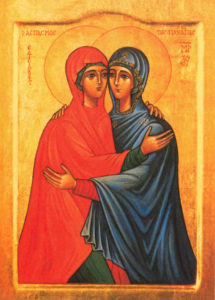
“A less remarked facet of Francis’s thought on this Biblical mystery is his dual emphasis on the Redeemer in the womb as the primary actor in this mystery and on Mary’s active, continual,and creative participation and cooperation in this first
manifestation of the Savior’s redemptive presence and activity, The experience to which Francis appeals, in his 1618 sermon for the Feast of the Visitation, to explain the divine-human dynamic in this mystery is divine inspiration.
Inspirations have a primary role in the Salesian spiritual universe: Francis also speaks of inspirations as a “heavenly ray that brings into our hearts a warm light that makes us see the good and fires us on to its pursuit”(Oeuvres, 5:89). The image of the divine ray of light finds a particular resonance in Francis’s theology of the Visitation, because,as we will see, our saint selects the same imagery to describe the impact of the Redeemer in the womb upon St. Joseph and St. John the Baptist.
In Francis’s view, Mary’s setting out to visit Elizabeth was her consent and response to a “divine inspiration” she received upon hearing from the angel Gabriel that Elizabeth had in her old age conceived a son (Lk 1:36) (Oeuvres, 9:158). The source of Mary’s inspiration is the Redeemer in the womb: “Ah! the first fruits of the movements of Him whom she has in her womb …. the Virgin is conscious only of what is within her, and … she breathes only the Savior” (Oeuvres,
14:324).27 The idea that the unborn Jesus, eager to begin His work of salvation, inspired Mary to undertake her visit to Elizabeth was not new. It is found in the Fathers of the Church and was commonplace in devotional authors But what is original in Francis’s treatment of this theme is his extensive development of it in terms of love.”
Source:
Mother of Our Savior and Cooperator in Our Salvation: Imitatio Mariae and
the Biblical Mystery of the Visitation in St. Francis De Sales
Joseph F. Chorpenning